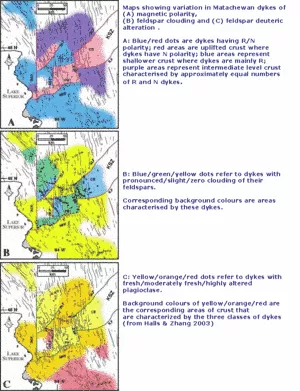
Henry Halls
-
E-mail:
-
Mailing Address:
3359 Mississauga Road
Mississauga ON L5L 1C6
Canada
Research

In 1985 I organized the first International Dyke Conference at University of Toronto Mississauga which brought together more than 100 scientists from 20 countries, the results of which were published as a Geological Association of Canada Special Paper 34 "Mafic Dyke Swarms" (Halls & Fahrig 1987). Since this inaugural meeting, International Dyke Swarm Conferences have been held approximately every five years. The sixth meeting (IDC6) was held Feb 4 - 7, 2010 in Varanasi, India, and a volume of papers presented at this meeting was published (2011). The next meeting is to be held in Yakytsk Russia in 2015. In 1988 I was elected the international leader of IGCP (International Geological Correlation Program) Project 257 on Mafic Dyke Swarms from which more than 30 publications including two books were produced. In the last five years about 30 dyke swarms from about 15 Precambrian cratons worldwide have been the subject of completed or ongoing studies by research groups from many countries including Canada, Australia, Finland, Russia, India, and Brazil. A common phrase used in many publications is "Giant radiating dyke swarms". This phrase was used for the title of a special Symposium, "Giant Radiaty Dyke Swarms and Mantle Plumes" that I covened for the 1991 Geological Association of Canada Annual Meeting in Toronto, and which drew an audience of over 100.
Publications
[Last five years only]
Kumar, A., Hamilton, M.A. and Halls, H.C. 2012. A Paleoproterozoic giant radiating dyke swarm in the Dharwar Craton, southern India . Geochem. Geophys. Geosyst., doi:10.1029/2011GC003926, in press.
Halls, H.C., Hamilton, M.A. and Denyszyn, S.W. 2011. The Melville Bugt dyke swarm of Greenland: a connection to the 1.5-1.6 Ga Fennoscandian Rapakivi granite province? In Dyke Swarms: Keys for Geodynamic Interpretation. Ed. R.K. Srivastava, Pub. Springer-Verlag, Berlin, p.605, Chapter 27, pp. 509-535 .Proceedings of the 6th International Dyke Symposium, held in Varanasi, India, February 4 to 7, 2010.
Evans, D.A.D. and Halls, H.C. 2010. Restoring Proterozoic deformation within the Superior Craton. Precambrian Research 183:474-489.
Hollings, P., Smyk, M., Halls, H.C. and Heaman L.M. 2010. The geochemistry, geochronology and paleomagnetism of dikes and sills associated with the Mesoproterozoic Midcontinent Rift of Northwestern Ontario. Precambrian Research 183: 553-571.
Halls, H. C. 2009. A 100 km-long paleomagnetic traverse radial to the Sudbury Structure, Canada and its bearing on Proterozoic deformation and metamorphism of the surrounding basement. Tectonophysics. 474: 493-506.
Denyszyn S. W., Davis D. W., and Halls H. C. 2009. Paleomagnetism and U-Pb geochronology of the Clarence Head dykes, Arctic Canada: Orthogonal emplacement of mafic dykes in a large igneous province. Canadian Journal of Earth Sciences. 46:155-167.
Denyszyn S. W., Halls H. C., Davis D. W., Evans, D. A. D. 2009. Paleomagnetism and U-Pb geochronology of Franklin dykes in High Arctic Canada and Greenland: A revised age and paleomagnetic pole constraining block rotations in the Nares Strait region. Canadian Journal of Earth Sciences. 46:689-705.
Halls, H.C. 2008. The Importance of Integrating paleomagnetic Studies of Proterozoic Dykes with U-Pb Geochronology and Geochemistry. In: Indian Dykes, Eds. Srivastava, R.K., Sivaji, C., and Rao, N.V.C. Narosa Publishing House Pvt. Ltd., New Delhi, India, pp. 1-22.
H.C. Halls, D.W. Davis, G.M. Stott, R.E. Ernst and M.A. Hamilton. Early 2008. The Paleoproterozoic Marathon Large Igneous Province: new evidence for a 2.1 Ga long-lived mantle plume event along the southern margin of the North American Superior Province. Precambrian Research 162: 327-353
H.C. Halls, A. Kumar, R. Srinivasan and M.A. Hamilton. 2007. Paleomagnetism and U–Pb geochronology of easterly trending dykes in the Dharwar craton, India: feldspar clouding, radiating dyke swarms and the position of India at 2.37 Ga, Precambrian Research 155: 47-68.
